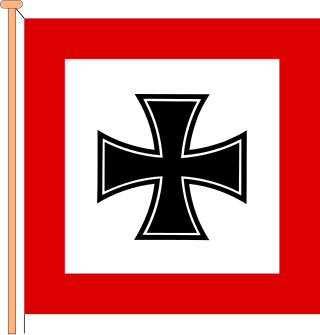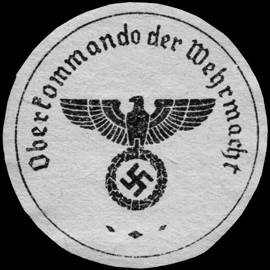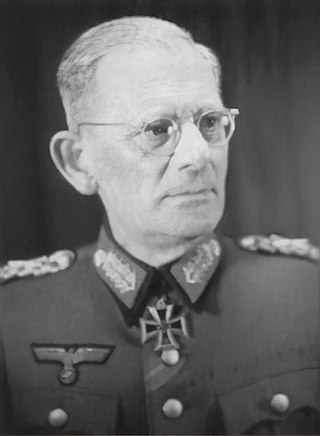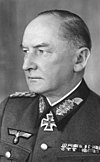
The Oberkommando des Heeres was the high command of the Army of Nazi Germany. It was founded in 1935 as part of Adolf Hitler's rearmament of Germany. OKH was de facto the most important unit within the German war planning until the defeat at Moscow in December 1941.

The Oberkommando der Wehrmacht was the High Command of the armed forces of Nazi Germany. Created in 1938, the OKW replaced the Reich War Ministry and had oversight over the individual High Commands of the country's armed forces: the Army, the Navy, and the Air force.
Generalfeldmarschall was a rank in the armies of several German states and the Holy Roman Empire (Reichsgeneralfeldmarschall); in the Habsburg monarchy, the Austrian Empire and Austria-Hungary, the rank Feldmarschall was used. The rank was the equivalent to Großadmiral in the Kaiserliche Marine and Kriegsmarine, a five-star rank, comparable to OF-10 in today's NATO naval forces.

Maximilian Maria Joseph Karl Gabriel Lamoral Reichsfreiherr von und zu Weichs an der Glon was a field marshal in the Wehrmacht of Nazi Germany during World War II.

The Supreme Commander is the highest ranked professional military officer in the Swedish Armed Forces, and is by NATO terminology the Swedish chief of defence equivalent. The Supreme Commander is the agency head of the Swedish Armed Forces and formally reports to the Government of Sweden, though normally through the Minister for Defence. The primary responsibilities and duties of the Supreme Commander are prescribed in an ordinance issued by the Government.
Military districts are formations of a state's armed forces which are responsible for a certain area of territory. They are often more responsible for administrative than operational matters, and in countries with conscript forces, often handle parts of the conscription cycle.
Army Group D was a German Army Group which saw action during World War II.

The Flensburg Government, also known as the Flensburg Cabinet, the Dönitz Government, or the Schwerin von Krosigk Cabinet, was the short-lived government of Nazi Germany during a period of three weeks around the end of World War II in Europe. The government was formed following the suicide of Adolf Hitler on 30 April 1945 during the Battle of Berlin. It was headed by Grand Admiral Karl Dönitz as the Reichspräsident and Lutz Graf Schwerin von Krosigk as the Leading Minister. The administration was referred to as the "Flensburg Government" because Dönitz's headquarters had been relocated to Flensburg in northern Germany on 3 May 1945.

The Oberkommando der Luftwaffe was the high command of the air force of Nazi Germany.

The Upper Rhine High Command, also incorrectly referred to as Army Group Upper Rhine, was a short-lived headquarters unit of the German Armed Forces (Wehrmacht) created on the Western Front during World War II. The Upper Rhine High Command was formed on 26 November 1944 and deactivated on 25 January 1945. The sole commander of this headquarters unit was Heinrich Himmler.
The Commander in Chief South was a high-ranking position in the Luftwaffe of Nazi Germany. All Luftwaffe units based in the Mediterranean and North African theatres of World War II fell under this command.
Army Group C was an army group of the German Wehrmacht, that was formed twice during the Second World War.

The Ministry of the Reichswehr or Reich Ministry of Defence was the defence ministry of the Weimar Republic and the early Third Reich. The 1919 Weimar Constitution provided for a unified, national ministry of defence to coordinate the new Reichswehr, and that ministry was set up in October 1919, from the existing Prussian War Ministry and Reichsmarineamt. It was based in the Bendlerblock building. The Wehrgesetz of 21 May 1935 renamed it the Reich Ministry of War, which was then abolished in 1938 and replaced with the Oberkommando der Wehrmacht.
Philipp Kleffel was a German general during World War II who commanded several corps. He was a recipient of the Knight's Cross of the Iron Cross of Nazi Germany.

Army Group H, Army Group Northwest after March 1945, was a German army group in the Netherlands and in Nordrhein-Westfalen during World War II.

Bodo Zimmermann was a German general during the Second World War. He also was one of the few recipients of both German crosses.

The Army of the Niemen was an army level command of the German Army in World War I.

The 25th Army was a World War II field army of the German Army. It had the highest ordinal number of any of the numbered German armies.
The General Commander in the South East was the overall command of the German Armed Forces in Greece and the Balkans between 1943 and 1945 during World War II. It was directly subordinate to German Armed Forces High Command.















